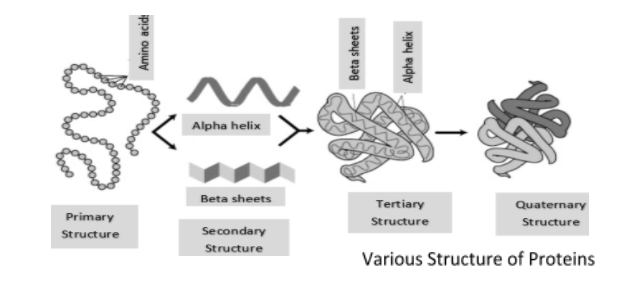
Explain the process of formation of complex protein?
Answer
481.8k+ views
Hint: Covalent and peptide bonds that bind an amino acid polymer together maintain a protein's structural integrity. Amino acids are the structural units (monomers) that constitute proteins.
Complete answer:
The peptide bond (-CO-NH-) is created between one molecule's amine group and the adjacent molecule's carboxyl group followed by the removal of a water molecule. Another way, this bond is an amide linkage. When peptide bonds are formed between more than ten amino acids, they form a polypeptide chain together.

The process of formation of complex protein takes place in the following manner:
> Primary structure: The proteins are the exact arrangement of the amino acids which form their chains. The exact protein sequence is very important, as it specifies the final fold and hence the protein structure. The number of clustered polypeptides together form proteins. These chains have amino acids arranged in a fixed sequence that is typical of the particular protein. A sequence alteration changes the whole protein.
> Secondary structure: Typically, these polypeptide chains fold due to the interaction of the peptide bond between the amine and carboxyl group. The structure refers to the form in which there may be a long polypeptide chain. They exist in two different forms such as α – helix and β – pleated sheet structures. This structure emerges from the normal folding of the polypeptide chain backbone due to the hydrogen bonding of the peptide bond between -CO group and -NH groups.
> Tertiary structure: This structure originates from further folding of the protein's secondary structure. This structure is stabilized by Hydrogen bonds (H-bond), electrostatic forces, disulphide bonds, and Vander Waals forces. The tertiary protein structure reflects the overall folding of the polypeptide chains, the secondary structure is further folded.
> Quaternary structure: The spatial organization of different tertiary structures elicits the quaternary structure. Any of the proteins are made up of two or more polypeptide chains, called subunits. The spatial arrangement of these subunits is known as a quaternary structure to each other.
Note: Distinct genetic diseases, such as cystic fibrosis, sickle cell anemia, albinism, etc., are caused by mutations resulting in modifications in the primary protein structures, which in turn contribute to alterations in the secondary, tertiary, and potentially quarterly structure.
Complete answer:
The peptide bond (-CO-NH-) is created between one molecule's amine group and the adjacent molecule's carboxyl group followed by the removal of a water molecule. Another way, this bond is an amide linkage. When peptide bonds are formed between more than ten amino acids, they form a polypeptide chain together.

The process of formation of complex protein takes place in the following manner:
> Primary structure: The proteins are the exact arrangement of the amino acids which form their chains. The exact protein sequence is very important, as it specifies the final fold and hence the protein structure. The number of clustered polypeptides together form proteins. These chains have amino acids arranged in a fixed sequence that is typical of the particular protein. A sequence alteration changes the whole protein.
> Secondary structure: Typically, these polypeptide chains fold due to the interaction of the peptide bond between the amine and carboxyl group. The structure refers to the form in which there may be a long polypeptide chain. They exist in two different forms such as α – helix and β – pleated sheet structures. This structure emerges from the normal folding of the polypeptide chain backbone due to the hydrogen bonding of the peptide bond between -CO group and -NH groups.
> Tertiary structure: This structure originates from further folding of the protein's secondary structure. This structure is stabilized by Hydrogen bonds (H-bond), electrostatic forces, disulphide bonds, and Vander Waals forces. The tertiary protein structure reflects the overall folding of the polypeptide chains, the secondary structure is further folded.
> Quaternary structure: The spatial organization of different tertiary structures elicits the quaternary structure. Any of the proteins are made up of two or more polypeptide chains, called subunits. The spatial arrangement of these subunits is known as a quaternary structure to each other.
Note: Distinct genetic diseases, such as cystic fibrosis, sickle cell anemia, albinism, etc., are caused by mutations resulting in modifications in the primary protein structures, which in turn contribute to alterations in the secondary, tertiary, and potentially quarterly structure.
Recently Updated Pages
Can anyone list 10 advantages and disadvantages of friction

What are the Components of Financial System?

How do you arrange NH4 + BF3 H2O C2H2 in increasing class 11 chemistry CBSE

Is H mCT and q mCT the same thing If so which is more class 11 chemistry CBSE

What are the possible quantum number for the last outermost class 11 chemistry CBSE

Is C2 paramagnetic or diamagnetic class 11 chemistry CBSE

Trending doubts
10 examples of friction in our daily life

The correct order of melting point of 14th group elements class 11 chemistry CBSE

Difference Between Prokaryotic Cells and Eukaryotic Cells

One Metric ton is equal to kg A 10000 B 1000 C 100 class 11 physics CBSE

What is the specific heat capacity of ice water and class 11 physics CBSE

State and prove Bernoullis theorem class 11 physics CBSE




